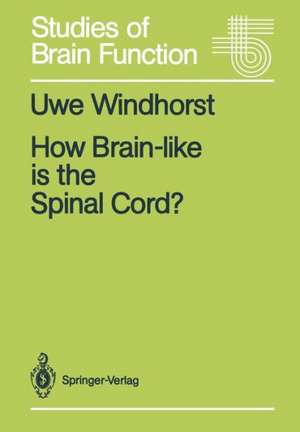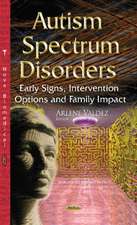How Brain-like is the Spinal Cord?: Interacting Cell Assemblies in the Nervous System: Studies of Brain Function, cartea 15
Autor Uwe Windhorsten Limba Engleză Paperback – 26 mai 2012
Din seria Studies of Brain Function
- 15%
 Preț: 631.72 lei
Preț: 631.72 lei - 15%
 Preț: 636.45 lei
Preț: 636.45 lei - 15%
 Preț: 647.73 lei
Preț: 647.73 lei - 15%
 Preț: 584.58 lei
Preț: 584.58 lei -
 Preț: 383.33 lei
Preț: 383.33 lei - 18%
 Preț: 784.13 lei
Preț: 784.13 lei - 15%
 Preț: 641.71 lei
Preț: 641.71 lei - 15%
 Preț: 640.06 lei
Preț: 640.06 lei - 15%
 Preț: 641.71 lei
Preț: 641.71 lei - 15%
 Preț: 639.41 lei
Preț: 639.41 lei - 15%
 Preț: 642.03 lei
Preț: 642.03 lei - 18%
 Preț: 721.63 lei
Preț: 721.63 lei - 15%
 Preț: 640.24 lei
Preț: 640.24 lei - 15%
 Preț: 632.37 lei
Preț: 632.37 lei - 15%
 Preț: 638.24 lei
Preț: 638.24 lei - 15%
 Preț: 639.41 lei
Preț: 639.41 lei
Preț: 394.51 lei
Nou
Puncte Express: 592
Preț estimativ în valută:
75.49€ • 80.72$ • 62.94£
75.49€ • 80.72$ • 62.94£
Carte tipărită la comandă
Livrare economică 18 aprilie-02 mai
Preluare comenzi: 021 569.72.76
Specificații
ISBN-13: 9783642511226
ISBN-10: 3642511228
Pagini: 356
Ilustrații: XVIII, 334 p.
Dimensiuni: 170 x 244 x 19 mm
Greutate: 0.57 kg
Ediția:Softcover reprint of the original 1st ed. 1988
Editura: Springer Berlin, Heidelberg
Colecția Springer
Seria Studies of Brain Function
Locul publicării:Berlin, Heidelberg, Germany
ISBN-10: 3642511228
Pagini: 356
Ilustrații: XVIII, 334 p.
Dimensiuni: 170 x 244 x 19 mm
Greutate: 0.57 kg
Ediția:Softcover reprint of the original 1st ed. 1988
Editura: Springer Berlin, Heidelberg
Colecția Springer
Seria Studies of Brain Function
Locul publicării:Berlin, Heidelberg, Germany
Public țintă
ResearchCuprins
1 Correlations Between Spike Trains of Supraspinal Neurones.- 1.1 Correlations Between Discharge Patterns of Cortical Neurones.- 1.2 The Basic Method of Cross-Correlating Spike Trains.- 1.3 Correlations Between Discharge Patterns of Cortical Neurones and Their Role in Some Recent Models of Brain function.- 1.4 Brainstem.- 2 Correlations Between Spinal Neurones.- 2.1 Correlations Between ?-Motoneurone Discharges.- 2.2 Correlations Between ?-Motoneurone Discharges.- 2.3 Correlations Between ?-Motoneurone Discharges.- 2.4 Summary.- 2.5 Correlations Between Muscle Afferent Discharges.- 2.6 The Effect of Fusimotor Input on Spindle Afferent Correlations.- 2.7 Summary.- 2.8 Effects of Correlations Between Presynaptic Fibres on Spinal Neurones.- 2.9 Interneuronal Circuits.- 3 Tremor States.- 3.1 Frequency-Displacement Amplitude Relations for Normal Hand Tremor.- 3.2 Muscle Contraction as a Stochastic Process.- 3.3 Localised Stretch Reflexes Acting as a Tremor-Suppressive Mechanism?.- 3.4 Further Feedback Systems.- 3.5 Plasticity in the Spinal Cord.- 3.6 Summary.- 4 Recurrent Inhibition and Proprioceptive Feedback.- 4.1 Fundamental Functions of the Spinal Cord.- 4.2 Specific Functions of Recurrent Inhibition and the Stretch Reflex.- 4.3 Structural and Functional Analogies Between Spinal Recurrent Inhibition and Proprioceptive Feedback.- 4.4 The Reafference Principle.- 4.5 The Renshaw Cell System as an Efference Copy?.- 4.6 Model-Reference Control Systems.- 4.7 Adaptive Control Systems.- 4.8 An Integrated Model Including Proprioceptive Feedback and Recurrent Inhibition.- 4.9 Remarks on the Function of the Integrated System.- 4.10 Are the Inputs to ?-Motoneurones and Renshaw Cells Matched to Each Other?.- 4.11 Relation of Fusi- and Skeletomotor Activation Patterns: TaskDependence.- 4.12 ?-Motoneurones and Renshaw Cells as Integrative Centres.- 4.13 Suggestions for Further Research.- 4.14 Summary.- 5 Problems in Motor Control.- 5.1 On the Modules of Motor Control.- 5.2 The Problem of the Variable(s) Controlled in Motor Acts.- 5.3 Which Are the Measured Variables?.- 5.4 Spatial Transformations.- 5.5 Temporal Aspects.- 5.6 Multimodal Organisation of Spinal Neural Assemblies.- 5.7 Summary.- 5.8 Concluding Remarks.- Appendix A Auto- and Cross-Correlations.- Appendix B Cross-Correlations Between Three Spike Trains.- Appendix C Event-Related Cross-Correlations.- Appendix D Statistical Analysis of Nonlinear Physiological Systems.- Appendix E On Spurious Synchronisation of Two Semiregularly Firing Neurones.- Appendix F Spectral Analysis.- Appendix G A Remark on Correlation Patterns.- References.












